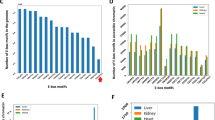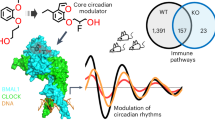Abstract
CLOCK (circadian locomotor output cycles kaput) and BMAL1 (brain and muscle ARNT-like 1) are both transcription factors of the circadian core loop in mammals. Recently published mouse CLOCK-BMAL1 bHLH (basic helix-loop-helix)-PAS (period-ARNT-single-minded) complex structure sheds light on the mechanism for heterodimer formation, but the structural details of the protein-DNA recognition mechanisms remain elusive. Here we have elucidated the crystal structure of human CLOCK-BMAL1 bHLH domains bound to a canonical E-box DNA. We demonstrate that CLOCK and BMAL1 bHLH domains can be mutually selected, and that hydrogen-bonding networks mediate their E-box recognition. We identified a hydrophobic contact between BMAL1 Ile80 and a flanking thymine nucleotide, suggesting that CLOCK-BMAL1 actually reads 7-bp DNA and not the previously believed 6-bp DNA. To find potential non-canonical E-boxes that could be recognized by CLOCK-BMAL1, we constructed systematic single-nucleotide mutations on the E-box and measured their relevant affinities. We defined two non-canonical E-box patterns with high affinities, AACGTGA and CATGTGA, in which the flanking A7-T7′ base pair is indispensable for recognition. These results will help us to identify functional CLOCK-BMAL1-binding sites in vivo and to search for clock-controlled genes. Furthermore, we assessed the inhibitory role of potential phosphorylation sites in bHLH regions. We found that the phospho-mimicking mutation on BMAL1 Ser78 could efficiently block DNA binding as well as abolish normal circadian oscillation in cells. We propose that BMAL1 Ser78 should be a key residue mediating input signal-regulated transcriptional inhibition for external cues to entrain the circadian clock by kinase cascade.
Similar content being viewed by others
Log in or create a free account to read this content
Gain free access to this article, as well as selected content from this journal and more on nature.com
or
Accession codes
References
Panda S, Hogenesch JB, Kay SA . Circadian rhythms from flies to human. Nature 2002; 417:329–335.
Reppert SM, Weaver DR . Coordination of circadian timing in mammals. Nature 2002; 418:935–941.
Green CB, Takahashi JS, Bass J . The meter of metabolism. Cell 2008; 134:728–742.
Maury E, Ramsey KM, Bass J . Circadian rhythms and metabolic syndrome: from experimental genetics to human disease. Circ Res 2010; 106:447–462.
Dunlap JC . Molecular bases for circadian clocks. Cell 1999; 96:271–290.
Zhang EE, Kay SA . Clocks not winding down: unravelling circadian networks. Nat Rev Mol Cell Biol 2010; 11:764–776.
Hogenesch JB, Gu YZ, Jain S, Bradfield CA . The basic-helix-loop-helix-PAS orphan MOP3 forms transcriptionally active complexes with circadian and hypoxia factors. Proc Natl Acad Sci USA 1998; 95:5474–5479.
Gekakis N, Staknis D, Nguyen HB, et al. Role of the CLOCK protein in the mammalian circadian mechanism. Science 1998; 280:1564–1569.
Massari ME, Murre C . Helix-loop-helix proteins: regulators of transcription in eucaryotic organisms. Mol Cell Biol 2000; 20:429–440.
Murre C, Bain G, van Dijk MA, et al. Structure and function of helix-loop-helix proteins. Biochim Biophys Acta 1994; 1218:129–135.
Ledent V, Vervoort M . The basic helix-loop-helix protein family: comparative genomics and phylogenetic analysis. Genome Res 2001; 11:754–770.
Munoz E, Baler R . The circadian E-box: when perfect is not good enough. Chronobiol Int 2003; 20:371–388.
Ephrussi A, Church GM, Tonegawa S, Gilbert W . B lineage--specific interactions of an immunoglobulin enhancer with cellular factors in vivo. Science 1985; 227:134–140.
Murre C, McCaw PS, Baltimore D . A new DNA binding and dimerization motif in immunoglobulin enhancer binding, daughterless, MyoD, and myc proteins. Cell 1989; 56:777–783.
Murre C, McCaw PS, Vaessin H, et al. Interactions between heterologous helix-loop-helix proteins generate complexes that bind specifically to a common DNA sequence. Cell 1989; 58:537–544.
Swanson HI, Chan WK, Bradfield CA . DNA binding specificities and pairing rules of the Ah receptor, ARNT, and SIM proteins. J Biol Chem 1995; 270:26292–26302.
Ueda HR, Chen W, Adachi A, et al. A transcription factor response element for gene expression during circadian night. Nature 2002; 418:534–539.
Storch KF, Lipan O, Leykin I, et al. Extensive and divergent circadian gene expression in liver and heart. Nature 2002; 417:78–83.
Panda S, Antoch MP, Miller BH, et al. Coordinated transcription of key pathways in the mouse by the circadian clock. Cell 2002; 109:307–320.
Yoo SH, Ko CH, Lowrey PL, et al. A noncanonical E-box enhancer drives mouse Period2 circadian oscillations in vivo. Proc Natl Acad Sci USA 2005; 102:2608–2613.
Hatanaka F, Matsubara C, Myung J, et al. Genome-wide profiling of the core clock protein BMAL1 targets reveals a strict relationship with metabolism. Mol Cell Biol 2010; 30:5636–5648.
Rey G, Cesbron F, Rougemont J, Reinke H, Brunner M, Naef F . Genome-wide and phase-specific DNA-binding rhythms of BMAL1 control circadian output functions in mouse liver. PLoS Biol 2011; 9:e 1000595.
Nakahata Y, Yoshida M, Takano A, et al. A direct repeat of E-box-like elements is required for cell-autonomous circadian rhythm of clock genes. BMC Mol Biol 2008; 9:1.
Huang N, Chelliah Y, Shan Y, et al. Crystal structure of the heterodimeric CLOCK:BMAL1 transcriptional activator complex. Science 2012; 337:189–194.
Nair SK, Burley SK . X-ray structures of Myc-Max and Mad-Max recognizing DNA: molecular bases of regulation by proto-oncogenic transcription factors. Cell 2003; 112:193–205.
Ferre-D'Amare AR, Pognonec P, Roeder RG, Burley SK . Structure and function of the b/HLH/Z domain of USF. EMBO J 1994; 13:180–189.
Brownlie P, Ceska T, Lamers M, et al. The crystal structure of an intact human Max-DNA complex: new insights into mechanisms of transcriptional control. Structure 1997; 5:509–520.
Parraga A, Bellsolell L, Ferre-D'Amare AR, Burley SK . Co-crystal structure of sterol regulatory element binding protein 1a at 2.3 Å resolution. Structure 1998; 6:661–672.
Ma PC, Rould MA, Weintraub H, Pabo CO . Crystal structure of MyoD bHLH domain-DNA complex: perspectives on DNA recognition and implications for transcriptional activation. Cell 1994; 77:451–459.
Ferre-D'Amare AR, Prendergast GC, Ziff EB, Burley SK . Recognition by Max of its cognate DNA through a dimeric b/HLH/Z domain. Nature 1993; 363:38–45.
Shimizu T, Toumoto A, Ihara K, et al. Crystal structure of PHO4 bHLH domain-DNA complex: flanking base recognition. EMBO J 1997; 16:4689–4697.
Longo A, Guanga GP, Rose RB . Crystal structure of E47-NeuroD1/beta2 bHLH domain-DNA complex: heterodimer selectivity and DNA recognition. Biochemistry 2008; 47:218–229.
Huang N, Chelliah Y, Shan Y, et al. Crystal structure of the heterodimeric CLOCK:BMAL1 transcriptional activator complex. Science 2012; 337:189–194.
Rutter J, Reick M, Wu LC, McKnight SL . Regulation of clock and NPAS2 DNA binding by the redox state of NAD cofactors. Science 2001; 293:510–514.
Wijnen H . Circadian rhythms. A circadian loop asSIRTs itself. Science 2009; 324:598–599.
Ramsey KM, Yoshino J, Brace CS, et al. Circadian clock feedback cycle through NAMPT-mediated NAD+ biosynthesis. Science 2009; 324:651–654.
Nakahata Y, Sahar S, Astarita G, Kaluzova M, Sassone-Corsi P . Circadian control of the NAD+ salvage pathway by CLOCK-SIRT1. Science 2009; 324:654–657.
Yoshitane H, Takao T, Satomi Y, Du NH, Okano T, Fukada Y . Roles of CLOCK phosphorylation in suppression of E-box-dependent transcription. Mol Cell Biol 2009; 29:3675–3686.
Tamaru T, Hirayama J, Isojima Y, et al. CK2alpha phosphorylates BMAL1 to regulate the mammalian clock. Nat Struct Mol Biol 2009; 16:446–448.
Blom N, Gammeltoft S, Brunak S . Sequence and structure-based prediction of eukaryotic protein phosphorylation sites. J Mol Biol 1999; 294:1351–1362.
Hornbeck PV, Chabra I, Kornhauser JM, Skrzypek E, Zhang B . PhosphoSite: A bioinformatics resource dedicated to physiological protein phosphorylation. Proteomics 2004; 4:1551–1561.
Yoo SH, Yamazaki S, Lowrey PL, et al. PERIOD2:: LUCIFERASE real-time reporting of circadian dynamics reveals persistent circadian oscillations in mouse peripheral tissues. Proc Natl Acad Sci USA 2004; 101:5339–5346.
Rohs R, Jin X, West SM, Joshi R, Honig B, Mann RS . Origins of specificity in protein-DNA recognition. Annu Rev Biochem 2010; 79:233–269.
Akashi M, Ichise T, Mamine T, Takumi T . Molecular mechanism of cell-autonomous circadian gene expression of Period2, a crucial regulator of the mammalian circadian clock. Mol Biol Cell 2006; 17:555–565.
Bass J, Takahashi JS . Circadian integration of metabolism and energetics. Science 2010; 330:1349–1354.
Sanada K, Okano T, Fukada Y . Mitogen-activated protein kinase phosphorylates and negatively regulates basic helix-loop-helix-PAS transcription factor BMAL1. J Biol Chem 2002; 277:267–271.
Gallego M, Virshup DM . Post-translational modifications regulate the ticking of the circadian clock. Nat Rev Mol Cell Biol 2007; 8:139–148.
Yu W, Zheng H, Houl JH, Dauwalder B, Hardin PE . PER-dependent rhythms in CLK phosphorylation and E-box binding regulate circadian transcription. Genes Dev 2006; 20:723–733.
Lee C, Etchegaray JP, Cagampang FR, Loudon AS, Reppert SM . Posttranslational mechanisms regulate the mammalian circadian clock. Cell 2001; 107:855–867.
Ripperger JA, Schibler U . Rhythmic CLOCK-BMAL1 binding to multiple E-box motifs drives circadian Dbp transcription and chromatin transitions. Nat Genet 2006; 38:369–374.
Otwinowski Z, Minor W . Processing of X-ray diffraction data collected in oscillation mode. Methods Enzymol 1997; 276:307–326.
Strong M, Sawaya MR, Wang S, Phillips M, Cascio D, Eisenberg D . Toward the structural genomics of complexes: crystal structure of a PE/PPE protein complex from Mycobacterium tuberculosis. Proc Natl Acad Sci USA 2006; 103:8060–8065.
Emsley P, Cowtan K . Coot: model-building tools for molecular graphics. Acta Crystallogr D Biol Crystallogr 2004; 60:2126–2132.
Adams PD, Grosse-Kunstleve RW, Hung LW, et al. PHENIX: building new software for automated crystallographic structure determination. Acta Crystallogr D Biol Crystallogr 2002; 58:1948–1954.
Tiscornia G, Singer O, Verma IM . Production and purification of lentiviral vectors. Nat Protoc 2006; 1:241–245.
Acknowledgements
We thank Dr Erquan Zhang (National Institute of Biological Sciences, Beijing, China) for critical reading of the manuscript and thoughtful discussions, Qin Cao for data collection, Pu Gao for the help of data processing, Xiaoxia Yu for the technical help of ultracentrifugation, Lorenzo Finci for language editing of the manuscript. This work was supported by the National Basic Research Program of China (973 program; 2011CB911103 to XDS), 985 and 211 grants from Peking University.
Author information
Authors and Affiliations
Corresponding author
Additional information
( Supplementary information is linked to the online version of the paper on the Cell Research website.)
Supplementary information
Supplementary information, Figure S1
The 2Fo-Fc electron density map of DNA (contoured at 1.5 σ) calculated from the molecular replacement solution. (PDF 765 kb)
Supplementary information, Figure S2
(A) Gel filtration results showed that, individual BMAL1 bHLH appeared to be only homodimer whereas individual CLOCK bHLH existed as equilibrium between homodimer and homotetramer in solution. (PDF 258 kb)
Supplementary information, Figure S3
ITC measurements of DNA binding affinities in the presence of NAD cofactors. (PDF 254 kb)
Supplementary information, Figure S4
Titration of CLOCK-BMAL1 bHLH domains into tandem E-box DNA. (PDF 252 kb)
Supplementary information, Table S1
Summary of ITC data (PDF 242 kb)
Rights and permissions
About this article
Cite this article
Wang, Z., Wu, Y., Li, L. et al. Intermolecular recognition revealed by the complex structure of human CLOCK-BMAL1 basic helix-loop-helix domains with E-box DNA. Cell Res 23, 213–224 (2013). https://doi.org/10.1038/cr.2012.170
Received:
Revised:
Accepted:
Published:
Issue date:
DOI: https://doi.org/10.1038/cr.2012.170
Keywords
This article is cited by
-
Prediction of mammalian tissue-specific CLOCK–BMAL1 binding to E-box DNA motifs
Scientific Reports (2023)
-
Stabilization of heterochromatin by CLOCK promotes stem cell rejuvenation and cartilage regeneration
Cell Research (2021)
-
Disrupted-in-schizophrenia 1 enhances the quality of circadian rhythm by stabilizing BMAL1
Translational Psychiatry (2021)
-
Highlighting the potential utility of MBP crystallization chaperone for Arabidopsis BIL1/BZR1 transcription factor-DNA complex
Scientific Reports (2021)
-
Molecular Evolution of clock Genes in Vertebrates
Journal of Molecular Evolution (2021)



